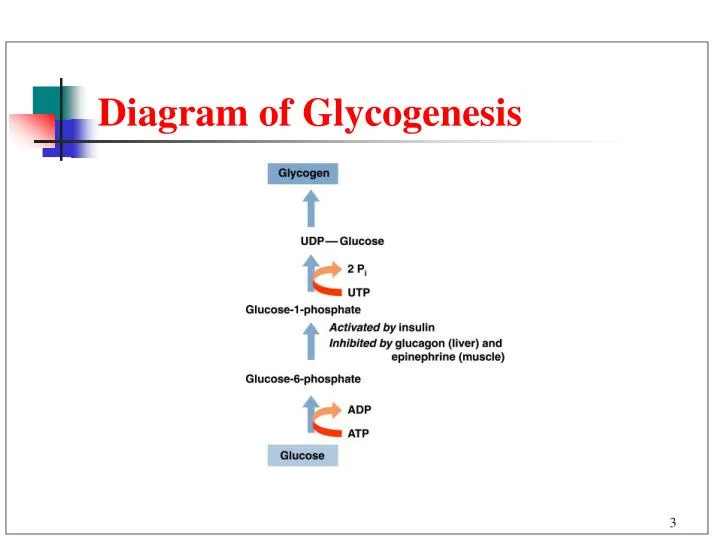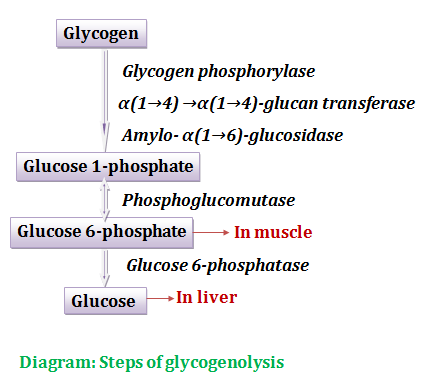What is Glycogenesis?
“Glycogenesis is the Conversion of glucose to Glycogen“
Glycogenesis is a biological process that happens in the liver & muscle cells that converts and stores molecules of glucose as glycogen.
- This mechanism enables the body to preserve an uninterrupted supply of glucose for energy synthesis, especially when the intake of glucose is low and as during fasting or hard activity.
- Glycogenesis is a complicated process involving numerous enzymatic processes, involving the transformation of glucose into glucose-6-phosphate and subsequently into glucose-1-phosphate, that is then utilized to build glycogen chains by enzymes like glycogen synthase and branching enzyme.
- Hormones like insulin, which stimulates glycogen synthesis, and glucagon, leading to the breakdown of glycogen and releases glucose into the circulation, control glycogenesis.
Steps of Glycogenesis
Glycogenesis is the process through which glucose is stored in the liver and muscle cells as glycogen. The stages involved in glycogenesis are as follows:
- Glucose uptake: Glucose transporters transfer glucose into liver and muscle cells.
- Conversion of glucose to glucose-6-phosphate (G6P): The enzyme hexokinase converts glucose to G6P once it enters the cell. ATP is required for this conversion.
- Conversion of G6P to glucose-1-phosphate (G1P): G6P is converted to G1P by the enzyme phosphoglucomutase.
- Formation of UDP-glucose: G1P combines with uridine triphosphate (UTP) to create UDP-glucose, which is mediated by the enzyme UDP-glucose pyrophosphorylase.
- Formation of glycogen chains: The enzyme glycogen synthase induces the synthesis of alpha-1,4-glycosidic bonds between glucose molecules to create glycogen chains. In this process, UDP-glucose acts as the donor of glucose residues.
- Formation of glycogen branches: Branching enzymes catalyze the production of alpha-1,6-glycosidic bonds among glucose molecules, resulting in the development of branches in the glycogen molecule.
- Glycogen storage: The glycogen molecule accumulates in the liver and muscle cells unless it is required in order to supply energy.

Glycogenesis is the process of turning glucose into glycogen, a form of storage for glucose that is more effective. To guarantee that glucose is stored and released as necessary for maintaining blood glucose homeostasis, this mechanism is regulated by a variety of enzymes and regulatory elements.
Regulation of Glycogenesis
A number of mechanisms carefully govern glycogenesis, the process by which glucose is stored as glycogen and released as needed in order to preserve blood glucose homeostasis. The principal regulators of glycogenesis include the following:
- Insulin: When blood glucose levels rise, the pancreas secretes the hormone insulin. Insulin increases glycogen production by blocking glycogen phosphorylase, an enzyme that breaks down glycogen, and by activating glycogen synthase, an enzyme that forms glycogen chains. The availability of glucose for glycogen formation is increased by insulin’s increased glucose absorption by muscle and liver cells.
- Glucagon: When blood glucose levels are low, the pancreas secretes a hormone called glucagon. As a result of glycogen phosphorylase activation and glycogen synthase inhibition caused by glucagon, glucose is released from glycogen storage and glycogen is broken down.
- Epinephrine: An adrenal gland hormone called epinephrine is produced in reaction to stress or physical activity. By activating glycogen phosphorylase and inhibiting glycogen synthase in muscle cells, epinephrine encourages the breakdown of stored glycogen, so increasing the amount of glucose that is available for cellular energy generation.
- AMPK: In reaction to low cellular energy levels, an enzyme called AMP-activated protein kinase (AMPK) is activated. By turning on glycogen phosphorylase and blocking glycogen synthase, AMPK encourages the breakdown of glycogen, releasing glucose from glycogen reserves in the process.
It takes a number of hormones and enzymes to control glycogenesis, which is a complicated process. The body receives a consistent source of energy through this control, which makes sure that glucose is stored and released when required to maintain blood glucose homeostasis. Diabetes and other disorders where the control of blood glucose levels is compromised can result from disruptions in glycogenesis.
Reverse glycogenesis/ Glycogenolysis
The process by which glycogen is converted into glucose is referred to as reverse glycogenesis or glycogenolysis. When blood glucose levels fall, as they do after exercise, fasting, or in reaction to stress, this process takes place.
The following are the steps involved in reverse glycogenesis:
1. Activation of glycogen phosphorylase: The enzyme that degrades glycogen is known as glycogen phosphorylase. Glycogen phosphorylase is turned on when blood sugar levels fall, which causes glycogen to be broken down into glucose-1-phosphate.
2. Conversion of glucose-1-phosphate to glucose-6-phosphate: Phosphoglucomutase is an enzyme that transforms glucose-1-phosphate to glucose-6-phosphate, which may subsequently be converted to glucose.
3. Conversion of glucose-6-phosphate to glucose: The enzyme glucose-6-phosphatase is in charge of changing glucose-6-phosphate into glucose, which may subsequently be released into the circulation and used as a fuel source.

The vital process of reverse glycogenesis keeps blood sugar levels stable and gives the body a constant supply of energy. Reverse glycogenesis is crucial for general health and wellbeing since it can cause problems like hypoglycemia or reduced glucose tolerance.
Significance of Glycogenesis
Glycogenesis, the process of converting glucose into glycogen, is essential for preserving blood glucose homeostasis and supplying the body with continuous energy. Some of the main implications of glycogenesis include the following:
- Maintaining blood glucose levels: By storing extra glucose as glycogen in the liver and muscle cells, glycogen helps to manage blood glucose levels. Glycogen is broken down in order to release glucose into the circulation and maintain blood glucose homeostasis during times of low blood glucose, such as during fasting or vigorous exercise.
- Providing energy: The body uses glycogen as an easily accessible source of energy, especially when there is an increased need for it, as during exercise or stressful situations.
- Maintaining muscle mass: During exercise, the glycogen that is stored in muscle cells serves as a source of energy, which helps to maintain muscle mass and stop muscle breakdown.
- Supporting brain function: The liver stores glycogen, which serves to ensure a consistent supply of glucose to the brain, especially during fasting or low glucose consumption. Glucose is the brain’s principal fuel source.
- Preventing hypoglycemia: Glycogen stored in the liver may be quickly degraded to release glucose into the circulation, aiding in the prevention of hypoglycemia, a disease defined by low blood glucose levels.
Differences between Glycogenesis and Glycogenolysis
| Parameter | Glycogenesis | Glycogenolysis |
| Definition | The process of glycogen synthesis or the conversion of glucose into glycogen for storage in the liver and muscles. | The breakdown of glycogen into glucose for energy production. |
| Function | To store glucose in the form of glycogen for future use. | To release glucose for immediate energy needs. |
| Occurs when | Blood glucose levels are high. | Blood glucose levels are low. |
| Hormone involved | Insulin is released by the pancreas to stimulate glycogenesis. | Glucagon and adrenaline are released by the pancreas and adrenal glands, respectively, to stimulate glycogenolysis. |
| Enzyme involved | Glycogen synthase is the key enzyme that catalyzes the conversion of glucose into glycogen. | Glycogen phosphorylase is the key enzyme that catalyzes the breakdown of glycogen into glucose. |
| End-Products | The end product of glycogenesis is glycogen, a polysaccharide made up of glucose units. | The end product of glycogenolysis is glucose, which is used by the body for energy production. |
| Location | Glycogenesis mainly occurs in the liver and muscles. | Glycogenolysis occurs in various tissues including the liver, muscles, and brain. |
| Regulation | Stimulated by insulin, which is released in response to high blood glucose levels. | Stimulated by glucagon and adrenaline, which are released in response to low blood glucose levels. |
| Energy requirement | It requires energy in the form of ATP. | It releases energy in the form of ATP. |